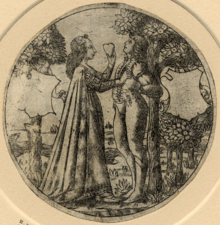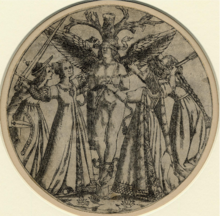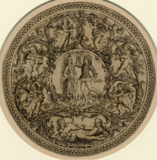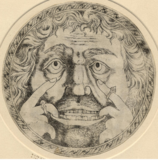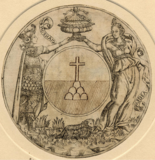
Andrea Mantegna was an Italian painter, a student of Roman archeology, and son-in-law of Jacopo Bellini.

Jacopo Caraglio, Giovanni Jacopo Caraglio or Gian Giacomo Caraglio known also as Jacobus Parmensis and Jacobus Veronensis was an Italian engraver, goldsmith and medallist, born at Verona or Parma. His career falls easily into two rather different halves: he worked in Rome from 1526 or earlier as an engraver in collaboration with leading artists, and then in Venice, before moving to spend the rest of his life as a court goldsmith in Poland, where he died.

Maso Tommasoii Finiguerra (1426–1464) was an Italian goldsmith, niellist, draftsman, and engraver working in Florence, who was incorrectly described by Giorgio Vasari as the inventor of engraving as a printmaking technique. This made him a crucial figure in the history of old master prints and remained widely believed until the early twentieth century. However, it was gradually realised that Vasari's view, like many of his assertions as to the origins of technical advances, could not be sustained. Typically, Vasari had overstated the importance of a fellow-Florentine, and a fellow-Italian, since it is now clear that engraving developed in Germany before Italy.

A putto is a figure in a work of art depicted as a chubby male child, usually naked and very often winged. Originally limited to profane passions in symbolism, the putto came to represent a sort of baby angel in religious art, often called cherubs, though in traditional Christian theology a cherub is actually one of the most senior types of angel.

Master E. S. is an unidentified German engraver, goldsmith, and printmaker of the late Gothic period. He was the first major German artist of old master prints and was greatly copied and imitated. The name assigned to him by art historians, Master E. S., is derived from the monogram, E. S., which appears on eighteen of his prints. The title, Master, is used for unidentified artists who operated independently. He was probably the first printmaker to place his initials on his work.

The Mantegna Tarocchi, also known as the Tarocchi Cards, Tarocchi in the style of Mantegna, Baldini Cards, are two different sets each of fifty 15th-century Italian old master prints in engraving, by two different unknown artists. The sets are known as the E-series Tarocchi Cards and the S-series Tarocchi Cards, and their artists are known as the “Master of the E-series Tarocchi” and the “Master of the S-series Tarocchi”. There are also a number of copies and later versions. Despite their name, they are educational visual aids, showing personifications of social classes or abstractions.
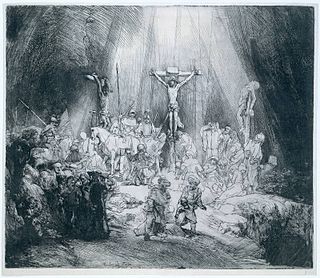
An old master print is a work of art produced by a printing process within the Western tradition. The term remains current in the art trade, and there is no easy alternative in English to distinguish the works of "fine art" produced in printmaking from the vast range of decorative, utilitarian and popular prints that grew rapidly alongside the artistic print from the 15th century onwards. Fifteenth-century prints are sufficiently rare that they are classed as old master prints even if they are of crude or merely workmanlike artistic quality. A date of about 1830 is usually taken as marking the end of the period whose prints are covered by this term.
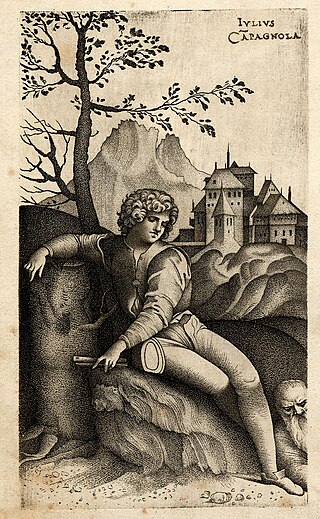
Giulio Campagnola was an Italian engraver and painter, whose few, rare, prints translated the rich Venetian Renaissance style of oil paintings of Giorgione and the early Titian into the medium of engraving; to further his exercises in gradations of tone, he also invented the stipple technique, where multitudes of tiny dots or dashes allow smooth graduations of tone in the essentially linear technique of engraving; variations on this discovery were to be of huge importance in future printmaking. He was the adoptive father of the artist Domenico Campagnola.

The Master of the Playing Cards was the first major master in the history of printmaking. He was a German engraver, and probably also a painter, active in southwestern Germany – probably in Alsace, from the 1430s to the 1450s, who has been called "the first personality in the history of engraving."
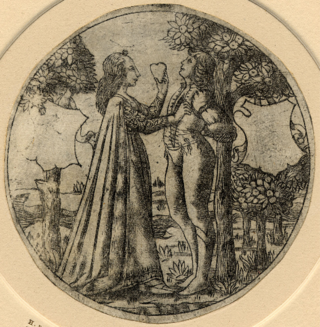
Baccio Baldini was an Italian goldsmith and engraver of the Renaissance, active in his native Florence. All that is known of Baldini's life, apart from the date of his burial in Florence, is what Vasari says of him: that Baldini was a goldsmith and pupil of Maso Finiguerra, the Florentine goldsmith who was, according to Vasari's incorrect claim, the inventor of engraving. Vasari says Baldini based all of his works on designs by Sandro Botticelli because he lacked disegno himself. Today Baldini is best remembered for his collaboration with Botticelli on the first printed Dante in 1481, where it is believed the painter supplied the drawings for Baldini to turn into engravings, but it does not seem to be the case that all his work was after Botticelli. He has long been attributed with a number of other engravings as the leading practitioner of the Florentine Fine Manner of engraving, this rather tentatively; he is often given a "workshop" or "circle" to ease uncertainty.

Giovanni Antonio da Brescia was an Italian engraver of northern Italy, active in the approximate period 1490–1519, during the Italian Renaissance. In his early career he used the initials "Z.A." to sign some twenty engravings, and until recently Zoan Andrea was regarded as a distinct printmaker; it is now realized that they are the same person, and the "Z.A." stood for Giovanni Antonio, "Zovanni" being a north Italian spelling. Around 1507 he began to use formulae such as "IO.AN.BX.", and signed some prints more fully. The real Zoan Andrea was a very obscure painter, documented as working in Mantua in the 1470s, who produced no engravings.
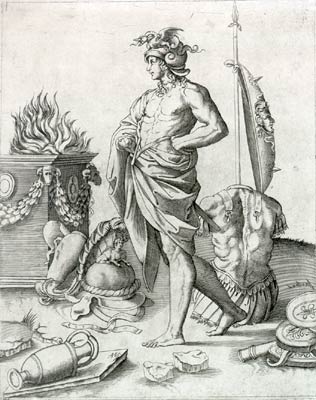
Agostino Veneziano, whose real name was Agostino de' Musi, was an important and prolific Italian engraver of the Renaissance.

The Battle of the Nudes or Battle of the Naked Men, probably dating from 1465–1475, is an engraving by the Florentine goldsmith and sculptor Antonio del Pollaiuolo which is one of the most significant old master prints of the Italian Renaissance. The engraving is large at 42.4 × 60.9 cm, and depicts five men wearing headbands and five men without, fighting in pairs with weapons in front of a dense background of vegetation.
Alpheus Hyatt Mayor (1901–1980) was an American art historian and curator at the Metropolitan Museum of Art, a leading figure in the study of prints, both old master prints and popular prints.

Benedetto Montagna was an Italian engraver and painter. Montagna was born in Vicenza, the son of the leading painter of the city, Bartolomeo Montagna, with whom he trained and perhaps continued to work. His approximately 53 engravings seem to have been produced in the period from about 1500 until his father died in 1523 and he inherited the workshop; in these years he was "the most prolific engraver of his generation in northern Italy". He ran the workshop into at least the 1540s, but his paintings fell behind the development of Italian styles as they largely follow his father's style, less successfully. Many do not survive. His prints are generally found more significant by art historians.
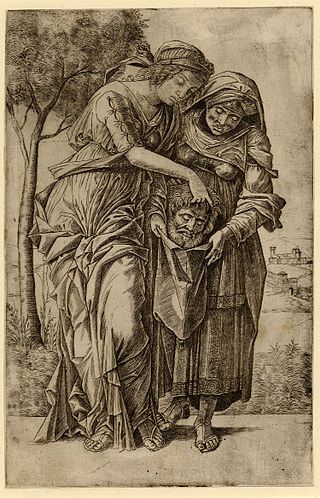
Girolamo Mocetto was an Italian Renaissance painter, engraver, and stained glass designer. He was heavily influenced by Domenico Morone, Giovanni Bellini, Bartolomeo Montagna, Cima da Conegliano, and especially Andrea Mantegna. He is most important as an engraver, and his engravings of the compositions of others are his most successful prints.
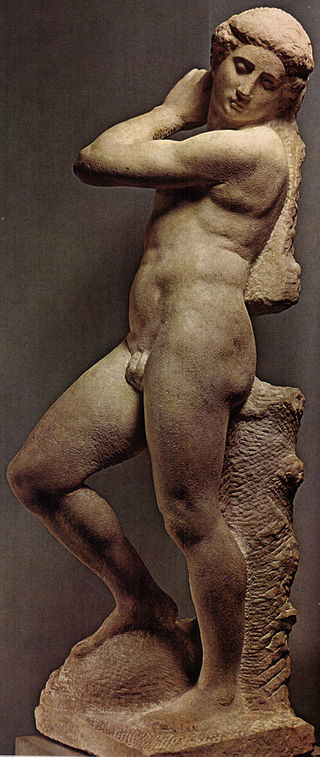
Apollo, also known as Apollo-David, David-Apollo, or Apollino, is a 1.46 m unfinished marble sculpture by Michelangelo that dates from approximately 1530. It now stands in the Bargello museum in Florence.

Mair von Landshut was a German engraver, painter, and designer of woodcuts, who worked in Bavaria. He probably came from Freising near Munich, and worked in both towns, as well as Landshut.
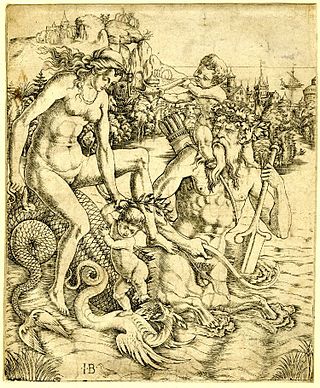
Giovanni Battista Palumba, also known as the Master I.B. with a Bird, was an Italian printmaker active in the early 16th century, making both engravings and woodcuts; he is generally attributed with respectively 14 and 11 of these. He appears to have come from northern Italy, but later worked in Rome. He specialized in subjects from classical mythology, as well as the inevitable religious subjects. Despite his relatively small output, he was a sophisticated artist, whose style shows a number of influences and changes, reflecting awareness of the currents in artistic style at the start of the High Renaissance. The signed prints are usually dated to around 1500–1511.

Master MZ was an engraver active in south Germany around 1500. He signed his 22 engravings with his monogram "MZ", and six are dated, all 1500, 1501 or 1503. He worked in Munich in Bavaria, and in 1500 seems to have been connected to the court of Albert IV, Duke of Bavaria. There are complicated but inconclusive arguments for and against identifying him with a goldsmith called Matthäus Zaisinger, a painter known as Master MS, and other figures.
